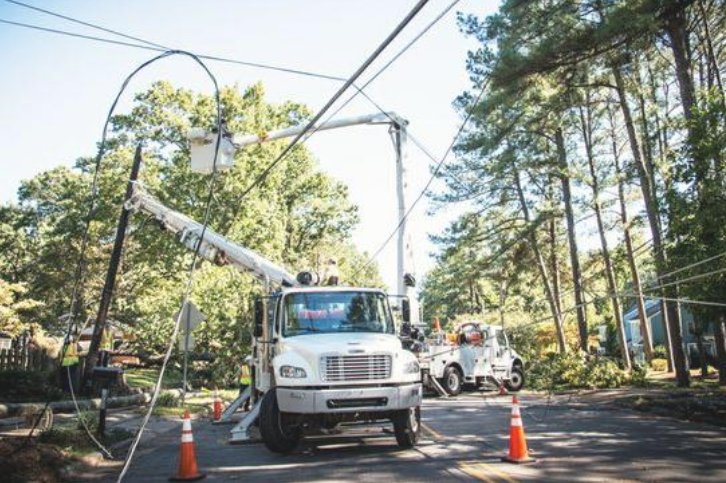
Date: 2024-07-17 Page is: DBtxt003.php txt00017103
USA / Energy
Resiliency
How these three costly storms could impact Duke Energy customers in the Carolinas ... Hurricane Florence, Hurricane Michael and Winter Storm Diego.
The energy industry ... oil and gas, electricity, nuclear, renewables ... all need to embrace a better way of accounting for and reporting their performance. Three are economic and money impacts, but also social impacts and environmental impacts ... ALL of these should be accounted for using an appropriate system of numbering that reflects not only the present but also what happened in the past and will happen in the future.
Peter Burgess

Hurricane Florence was by far the costliest of the storms. The two Duke utilities spent a total of nearly $560 million in the Carolinas restoring power and repairing damage from Florence. DUKE ENERGY
It cost Duke Energy Corp.’s two Carolinas utilities more than $760 million to restore power and repair storm damage from 2018’s triple whammy of Hurricane Florence, Hurricane Michael and Winter Storm Diego.
Duke Energy Progress and Duke Energy Carolinas each say they will be seeking rate hikes in 2019 and warn the N.C. Utilities Commission in filings Friday that the storm costs will be a major factor.
“The company recognizes that the unprecedented costs to respond to Hurricanes Florence and Michael and Winter Storm Diego will have a corresponding rate impact on customers, if found to be reasonable and prudent by the commission,” each says in its filing. “These effects are material to the company’s financial standing and could materially impair the company’s financial stability and ability to attract capital on reasonable terms.”
The utilities note that the storm costs are akin to the costs of building a new power plant. And they asked the commission for special provisions in how Duke (NYSE: DUK) is compensated for those costs, including the unusual step of allowing the utilities to make a rate of return on the deferred costs.
That will increase the costs to customers for repair and restoration from these storms. But the utilities argue that it will ensure that the utilities can continue to offer reliable service at reasonable costs in the future.
Progress hit hardest
The utilities are not asking customers to pay the entire storm costs. But the allowance the utilities give customers for routine storm costs and then set aside for extreme storm costs are dwarfed by the costs of the three destructive storms that all hit in the last three months or so.
Duke Progress, based in Raleigh and primarily covering largely eastern North Carolina and northeastern South Carolina, was the hardest hit.
It spent about $557 million on restoring and repairing damage from Florence, Michael and Diego. The filing says about $461 million of that was the operations and maintenance costs attributed to repair crews, and $96 million was spent on replacing equipment and infrastructure.
Florence caused by far the most damage, accounting for $501 million of the storm expenses reported by Duke Progress. Michael, by comparison, accounted for $33 million, and Diego accounted for $23 million.
Diego slammed Duke Carolinas
Duke Carolinas spent approximately $204 million on the three storms, according to its filing Friday with the N.C. Utilities Commission. The utility says about $183 million of that was spent on operations and maintenance crews restoring power. The replacement costs for damaged equipment and infrastructure totaled $21 million.
Winter Storm Diego was the most expensive of the three, racking up $74 million in total costs — $70 million of that was for the crews restoring power. Michael was close behind at $72 million overall, and Florence accounted for $58 million in storm costs.
All those are totals for North and South Carolina. The costs will be apportioned between the two states, but since the North Carolina franchise for each utility is much larger than the South Carolina franchise, the N.C. costs will be higher.
Duke Progress asserts North Carolina’s share of its storm costs total more than $462 million of its 2018 storm costs. The utility proposes allowing $22 million of that as routine storm costs, not to be charged to customers. The company also had set aside a little more than $11 million for extraordinary storm costs, which will also come off the tab.
But that leaves almost $429 million in costs the utility believes should be passed on to customers.
To reduce the annual impact on bills, Duke Progress wants to collect those costs over eight years, rather than the normal five years the commission had ordered for storm recovery in the past.
Duke Energy Carolinas calculates its N.C. share of the storm costs at $159 million. It proposes $19 million to count as routine storm costs, and it had $17.8 million set aside for extraordinary costs. That leaves $122 million to be collected from customers, again over eight years.
The utilities also propose other measures to mitigate the impact on customers. More details will be available when they file for rate increases next year.
--------------------------------------------------------
COMPANIES IN THIS ARTICLE Duke Energy Corp. Charlotte, NC Utilities $24.5B Revenue 30,083 Employees See full profile
SPORTS BUSINESS Tepper's big plans: retractable dome stadium, MLS franchise and more David Tepper at practice
RETAILING Charlotte restaurant group snaps up popular Dilworth eatery Lebowski's Neighborhood Grill at 1524 East Blvd. is known for its wings, especially the popular 'gold rush' flavor with mustard-based barbecue sauce.
COMING EVENT 2019 Best in HR Awards Sept. 6